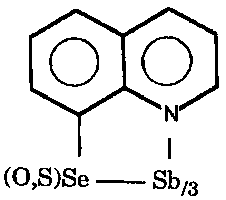
STRUCTURE OF ANTIMONY (III) 8-SELENOL-,8-MERCAPTO-AND 8-OXYQUINOLINATE. L.Pech, Yu..Bankovsky, V.Belsky, A.Stach, J.Ashaks, Institute of Inorganic Chemistry,Latvian Academy of Sciences, Latvia
Investigation structure of 8-oxyquinoline, 8-mercaptoquinoline and 8-selenolquinoline metal complexes is of a great interest because it offers the possibility to elucidate some regulaties of spatial structure of the mentioned compounds depending on the nature of ligand (O,S,Se) atoms. The object of the present work is the study of crystal and molecular structure of Sb(C9H6 NSe)3(I) in comparison with the structures of Sb(C9H6NS)3(II) and Sb(C9H6NO)3(III).
By our offered X-raying method values of dihedral angles between coordination planes restricted by OSbN, SSbN and SeSbN (in Fig.) it is shown, that in molecules of octahedral complexes of transition metals the angles are close to 90deg.. But these angles diverge considerably more in octahedral complexes of non-transition elements.
The dihedral angles between the coordination planes SeSbN, SSbN and OSbN (1/2,1/3,2/3) in the complexes I-III are: 84.0, 84.0, 84.0deg.(I), 78.1, 85.7, 83.9deg.(II) and 79.4, 84.0, 163.1deg.(III).
The angles Se-Sb-Se, S-Sb-S and O-Sb-O of chelate metallocycles I-III are 87.1, 87.1, 87.1deg. (I); 87.3, 84.3 and 87.2deg. (II) and 86.8, 86.5 and 75.4deg.(III).The breach of five membered metallocycles trough the lines Se...N, S...N and O...N angles are 20.1, 20.1, 20.1deg. (I); 29.6, 11.2, 28.2deg. (II); 0.3,2.9 and 9.8deg. (III).
Crystal data I - a=b=c=11.2710(10) Å, [[alpha]]=[[beta]]=[[gamma]]=99.32(2)deg., Z=2, sp.gr. R3.
The present research was made possible in part of Grants LBC000 and LJJ100 from the International Science Foundation.
